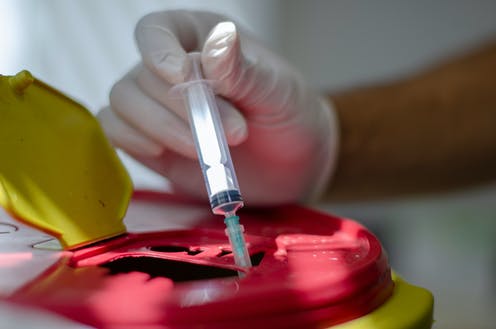shutterstock
Now that COVID-19 vaccination campaigns are underway in many countries, concerns have emerged about the availability of stock, the timing of deliveries, and the potential for thousands of vaccines to be wasted at each stage of the supply chain.
Because vaccines require transporting and storing at chilled temperatures — the Pfizer/BioNtech vaccine at least as low as -60⁰C — vaccine vials that have not been constantly chilled have reportedly been thrown away in some parts of Germany. An employee in a medical centre in Wisconsin allegedly allowed hundreds of vaccine doses to spoil outside a refrigerator. Given the slow roll-out in many countries, vaccines might even expire before medical professionals have a chance to administer them.
So far, anecdotal evidence points to isolated incidents with relatively low volumes of vaccine waste. However, the French Directorate General of Health has stated that it is operating with the cautious estimate of a 30% wastage rate on COVID-19 vaccines distributed in the country.
That might seem a huge and concerning figure, especially when the challenges of securing personal protective equipment (PPE) for hospital staff earlier in the pandemic remain fresh in the memory. Potentially wasting so much of a scarce, lifesaving resource is frightening.
Waste is expected
But vaccine wastage is not unusual — it’s expected. In a 2005 paper, the World Health Organization (WHO) reported vaccine wastage at over 50% around the world, a number still cited by the United Nations Environment Programme today. Some waste is unavoidable. But a good understanding for where waste occurs in the vaccine supply chain — and targeted action at crucial points of that chain — can help to minimise it.
The WHO differentiates between “closed vial wastage” (which occurs before vaccine vials are opened) and “open vial wastage” (occurring after vials have been opened). Closed vial wastage occurs mostly because of errors in storage and transportation, like when vials get too warm or too cold. Open vial wastage occurs mainly because of immunisation workers’ practices, or because unused doses from multi-dose vials are thrown away.
Multi-dose vials
Vaccines often come in multi-dose vials, because they are more economical. Currently, the Pfizer/BioNtech vaccine is delivered in vials of five doses, Oxford/AstraZeneca vials contain eight or ten doses and Moderna vials contain ten doses. This is important because wastage rates tend to increase with the size of multi-dose vials. Indicative wastage rates start at 5% for single-dose vials and are at 15%-25% for 10-dose vials.
Overfill, or additional liquid in vials, is common in order to accommodate for the odd spill or slight inaccuracies. However, the amount left in the Pfizer/BioNtech vials is much higher than usual.
There were concerns that due to this, 150,000 doses might have been wasted in the UK alone if healthcare staff had not been aware that they were able to use the extra dose.
The European Medicines Agency, the US Food and Drug Administration and the UK’s Medicine and Healthcare products Regulatory Authority have now all amended their regulations to state that a sixth dose of the Pfizer/BioNtech vaccine can be drawn from each vial.

PureRadiancePhoto/Shutterstock
Spoiled vaccines
Once a multi-dose vial has been opened, it has a relatively short shelf life. In some scenarios, there might simply not be enough people requiring a vaccine at a particular location within the shelf life of the vaccine. This is why it is essential to carefully plan how many people will be vaccinated in any facility at any given time.
With strict guidelines on the order in which people need to be vaccinated in place in most countries, this means getting a certain group (like those aged over 80) together quickly, safely and efficiently. This is an organisational challenge.
The creation of mass vaccination hubs is a way to address this challenge of matching supply with demand. Hubs enable larger batches of people to be vaccinated, using up open vials more efficiently. Safe transport to and storage at these vaccination hubs will also reduce wastage — especially for the Pfizer/BioNtech vaccine, which requires stable, ultra-cold conditions.

Haris Mm/Shutterstock
With careful planning, key causes of vaccine waste can be avoided. Having a pool of available substitutes to receive vaccinations for those who do not attend vaccination clinics also ensures maximum use of stock and lower levels of waste. In the Canadian province of Alberta, overbooking appointments to avoid wastage from no-shows has led to waste on site being reported at only 0.3%.
However, an immunisation campaign of this size will rely on many different vaccination locations, with hospitals, general practice staff, pharmacists and mobile teams all playing important roles. For people who cannot access mass vaccination hubs, these options are essential.
They also offer other advantages. A local pharmacist will often be a trusted source of health information which could be able to alleviate vaccine hesitancy. On the other hand, with more sites and people involved in the process, there are more potential points of waste creation due to human error.

EPA
Perfecting the process
The pressure is high. The scale of this global immunisation campaign is unprecedented — as is the public scrutiny. Police escorts for vaccine deliveries highlight just how high the stakes are, and the anxiety around sabotage or theft. The world shares this scarce resource, and countries need to learn from mistakes made and best practices developed elsewhere.
In the UK at least, stringent measures are in place to avoid unnecessary waste. Such effort needs to be maintained as the strategy for vaccine deployment develops, responding to increased demand and product availability.
![]()
The authors do not work for, consult, own shares in or receive funding from any company or organisation that would benefit from this article, and have disclosed no relevant affiliations beyond their academic appointment.











